Bill Martin
February 9, 2021, Justtalk blog
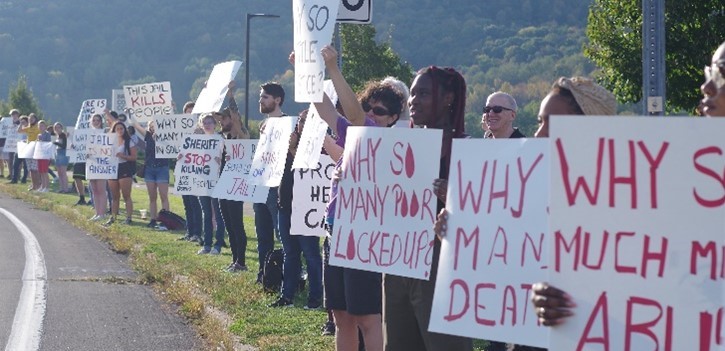
Photo Credit: Kojo Senoo
Faced with unrelenting waves of protest against police brutality, elected officials have mobilized in response. Local sheriffs, police chiefs, and mayors first proposed and then enacted new laws to incarcerate those who “annoy” the police, arresting protestors in the process.[1] Governor Cuomo, facing larger Black and Latinx insurgencies and voters, responded with an executive order in August that required all police departments—except state police departments including SUNY state police—to conduct a review and send a final reform report to the state by April 1, 2021.[2] The cudgel: an open threat to cut state aid to cities and counties that don’t comply.
Local departments led by the Binghamton Police Department and the County Sheriff started late on their reform review, with a top-down, hand-picked set of commission members.[3] Public (Zoom and phone) call-in meetings for both the city and the county have been swamped by demands to downsize police operations and fund alternative health and violence prevention programs. From the thin public records available,[4] it appears the commission proposals will be limited to recommendations that police departments increase their efforts to hire more diverse officers, expand cultural competency and de-escalation training, team up with mental health and addiction counselors, and expand community policing.
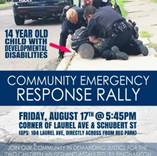
All these measures have been recommended by national and local commissions for over 30 years and have failed us–as any one who dips their toes into the subject through a Google search comes to know very quickly. George Floyd was killed in a city whose police department had undergone a deep set of these reforms.[5] Data shows that hiring more officers of color does not alter police violence and brutality.[6] Despite diversity and sensitivity training Binghamton’s police force has faced protests alleging abuse of children of color.[7] Proliferation of teams of police officers and medical counselors, under direct police control, along with restricted medical treatment in the jail has only increased the use of the police as the primary means to address substance use disorders.[8] Indeed such programs threaten to expand and cement the use of the jail as the county’s primary drug and mental health treatment center and increase drug overdoses.[9] Pledges by the City of Binghamton to hire and deploy a more diverse force are heard year after year,[10] but little progress takes place; at last count the city force was 1.5% Black.[11] The Broome County Sheriff simply states “We don’t hire by race”[12]—and supervises a 160+ person force that is 98% white (as far as we can uncover[13]). Why not Black officers? Harder recently blamed the local NAACP for not acting better as a recruiting arm for him.[14]
Community Actions
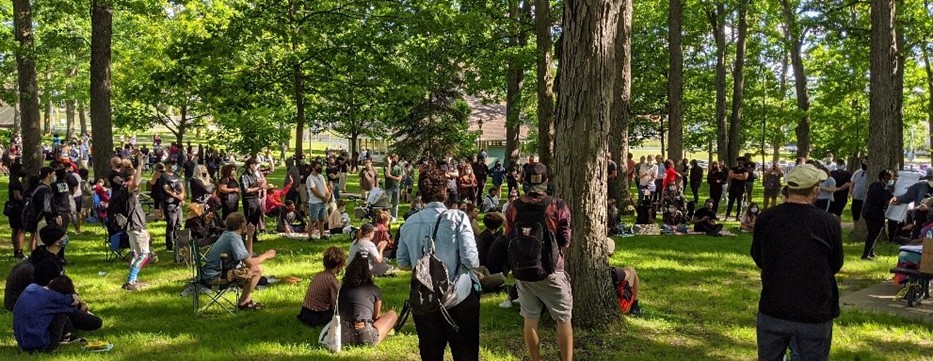
Photo Credit: Bill Martin
What is the local community to do? Actually a lot has been done at the grassroots. For over five years many community organizations have called and rallied for change in mass policing and mass incarceration policies, most prominently Citizen Action, Justice and Unity for the Southern Tier, Progressive Leaders of Tomorrow, and Truth Pharm. For over five years people have rallied at the local jail, protesting over-incarceration and deaths in the jail.[15] Black residents have rallied against police abuse of local Black youth.[16] Last summer over a thousand persons marched through town demanding change as part of a Black Lives Matter rally launched by local Black high school students.[17] Over 400 persons met later in Rec Park to discuss and hammer out a collective plan to change local policing priorities and practices.[18] A local coalition of community groups—Divestment, Accountability, Reinvestment in Our Community (DAROC)—advanced these discussions at community meetings in multiple city parks, and is now presenting the results to elected officials.
City and County Responses
All to no apparent avail. The City of Binghamton and Broome County officials refuse, in direct opposition to the Governor’s recommendations, to speak with the most active community organizations. The Governor’s guidebook is quite clear that it would be a mistake “to impose to-down solutions” and that reform efforts and meetings should “involve the entire community in the discussion” including interested non-profit groups.[19]
Neither the City nor County have done this. Commissions have been composed and imposed by the mayor and the sheriff, with the mayor calling the community groups who have led local protests “hate groups” and the sheriff simply refusing to discuss the issue.[20] To date the only forums for public comment have been call-in Zoom meetings which permit short statements by outsiders with no response by committee members.[21] The mayor and sheriff, and most commissioners, are either silent or absent completely.[22] This has made it impossible of course to consider, again as Cuomo’s guidelines dictate, “what grievances your community has had with its police force in the past and what you can learn from those instances.”[23]
Questions to Ask
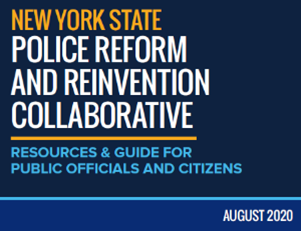
There is no sign that either city or county meetings are pursuing even the most elemental questions raised by the state guidebook for all reform efforts:
- How often are complaints made about the police?
- Do complaints come from a particular portion or portions of the community?
- Should you deploy social service personnel instead of or in addition to police officers in some situations?
- Do you want police to respond to mental health calls?
- Do you want police to respond to substance abuse/overdose calls?
- Do you want police to respond to calls regarding the homeless?
- Are there other matters for which the community currently turns to its police for assistance that might be better addressed by others with different skills and expertise? (pp. 12-13)
Neither the city nor the county seems to have considered alternatives raised in the state guidebook, including alternative investments of public funds in:
- Community violence interruption
- Parent support
- Youth development
- Addressing trauma and violence at home (pp. 14-16)
Nor is there any sign that local meetings will consider any changes demanded by community organizations or discussed in the state guidebook, including cutting police in schools (p. 18), demilitarizing police forces (pp. 20, 21), collecting and making available stop data, ending shooting at moving vehicles (p. 31), and cutting back on racialized facial recognition data (p. 34).
As currently composed, the city and county reform initiatives are stillborn: they are unrepresentative, exclude community groups and individuals who have been most active in dealing with police issues, fail to address racialized policing and incarceration, and are directed to suggest only initiatives that lead to greater funding and control of the police over social illnesses, most notably mental health and substance use disorders.
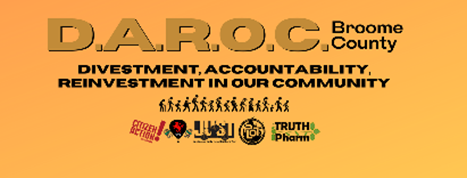
Where to start
Community organizations through DAROC provide an alternative agenda, most notably in their January 28, 2021 letter to the mayor and city council members. It recommends many initiatives the city and county would do well to consider, including
- Ending racial profiling
- Implementing mandatory date collection and reports on stops, tracking, and surveillance
- Ending police in schools
- Increasing transparency and compliance with state laws on disciplinary records and freedom of information requests
- Eliminating the militarization of the police, especially military grade weapons and armored personnel carriers
- Diverting funding and resources to independent mental health/substance use counselors, reentry programs, food, youth and educational programs
- Creating an empowered oversight board
A similar set of proposals are targeted at the much larger budget and operations of the county sheriff.[24]
These are not radical demands. They have been adopted by large and small cities across the country. One might go further and argue as many do for a more substantive transformation of how we define public safety and work to counter violence and harm (see suggested readings below).
The bottom line? All current indications are that the city and county will generate a report that fails to meet even the minimal standards of the state mandate, with state aid cuts to local county and city budgets being the only credible state response.
Binghamton and Broome County residents deserve better.
***
Further reading on Police Reform
Mariame Kaba, Yes, We Mean Literally Abolish the Police, New York Times, June 12, 2020
Alex Vitale, “The Answer to Police Violence is Not ‘Reform’,” Guardian, May 31, 2020
Brendan McQuade, “Against Community Policing,” Jacobin, Nov 18 2015
Timothy Williamsburg, Facial Recognition Software Moves From Overseas Wars to Local Police,” New York Times, August 12, 2015
Alexis Okeowo, “How to Defund the Police,” New Yorker, June 26, 2020
José Martín “Policing is a Dirty Job, But Nobody’s Gotta Do It: 6 Ideas for a Cop-Free World,” Rolling Stone, June 2, 2020
Bazelon Center, “’Defunding the Police’ and People with Mental Illness,” August 2020
M4BL, Defund Toolkit, August 20, 2020
Justice and Unity for the Southern Tier, Defund the Sheriff, Fund Community Health, June 6, 2020
DAROC Letter to the mayor and City Council, January 28, 2021
DAROC/JUST, County funding briefing, September 17, 2020
Communities United for Police Reform, NYC Budget Justice Campaign Demands, July 1, 2020
Bill Martin, “Defund the (Campus) Police,” June 15, 2020
Notes
[1] Bill Martin, “Broome County’s Censorship Bill: It’s All About the Police,” JUST Talk (blog), December 5, 2019, https://justtalk.blog/index.php/2019/12/05/broome-countys-censorship-bill-its-all-about-the-police/; Gabe Altieri, “Broome County Passes ‘Annoyance Law’ | WSKGWSKG,” December 20, 2019, https://wskg.org/news/broome-county-passes-annoyance-law/.
[2] “Governor Cuomo Announces New Guidance for Police Reform Collaborative to Reinvent and Modernize Policing,” Governor Andrew M. Cuomo, August 17, 2020, https://www.governor.ny.gov/news/governor-cuomo-announces-new-guidance-police-reform-collaborative-reinvent-and-modernize.
[3] For an early evaluation of the late start see Tarik Abdelazim, “Binghamton’s Police Reform Panel: Not Even Started, and Already a Failure,” The Bridge (blog), November 18, 2020, https://binghamtonbridge.org/binghamtons-police-reform-panel-not-even-started-and-already-a-failure/. The Johnson City, Endicott, and Vestal police departments are considerably smaller and have barely begun the reform process as of early February 2021. The SUNY-Binghamton State Police department is larger than those of the smaller cities but is not subject to the state mandate.
[4] See the official records at “Broome County Police Review Taskforce | Broome County,” accessed February 8, 2021, https://gobroomecounty.com/countyexec/policereviewtaskforce; “2021 Binghamton Police Reform & Reinvention Collaborative | City of Binghamton,” accessed February 8, 2021, http://binghamton-ny.gov/2021-binghamton-police-reform-reinvention-collaborative.
[5] See Alex S. Vitale, “The Limits of Police Reform,” in The End of Policing (Verso, 2017), 1–29.
[6] Tom Jacobs, “Black Cops Are Just as Likely as White Cops to Kill Black Suspects,” Pacific Standard, accessed February 8, 2021, https://psmag.com/social-justice/black-cops-are-just-as-likely-as-whites-to-kill-black-suspects; Jennifer Cobbina and Alex S. Vitale, “Why Police Diversity Won’t Fix the Problems of Policing,” The Crime Report, January 18, 2021, https://thecrimereport.org/2021/01/18/1196218/.
[7] Progressive Leaders of Tomorrow, Binghamton Police Assault Black/Disabled Children Near Rec Park, Binghamton Police Assault Black/Disabled Children Near Rec Park, accessed February 8, 2021, https://www.facebook.com/BingPLOT/videos/binghamton-police-assault-blackdisabled-children-near-rec-park/2060104890689388/; Justice and Unity for the Southern Tier, “Rally vs. BPD Violence Aug 17 – Justice and Unity for the Southern Tier,” August 2017, https://www.justicest.com/index.php/2018/08/15/rally-vs-bpd-violence-aug-17/.
[8] Alexis Pleus and Kevin Revier, “Your Turn: Skepticism over Jail Addiction Treatment Plan,” Press & Sun-Bulletin, accessed February 8, 2021, https://www.pressconnects.com/story/opinion/2018/07/28/turn-skepticism-jail-addiction-treatment-plan/37132217/.
[9] “Truth Pharm: ‘Incarceration for Drug Offenses Increases Overdoses,’” accessed February 8, 2021, https://www.wicz.com/story/37268578/truth-pharm-incarceration-for-drug-offenses-increases-overdoses.
[10] Steve Reilly, “Diversity Eludes Local Law Enforcement Agencies,” Press & Sun-Bulletin, accessed February 8, 2021, https://www.pressconnects.com/story/news/public-safety/2014/09/26/diversity-eludes-local-law-enforcement-agencies/16285803/.
[11] Ashley Biviano, “How Police Reforms Are Taking Shape in Broome, and What’s Stopping Them,” Press & Sun-Bulletin, accessed January 6, 2021, https://www.pressconnects.com/story/news/public-safety/2020/07/06/broome-county-binghamton-endicott-vestal-police-reforms-black-officers/3258752001/.
[12] Reilly, “Diversity Eludes Local Law Enforcement Agencies.”
[13] “Whose White at the BC Jail? We Don’t Know? – JUST Talk,” accessed December 4, 2019, https://justtalk.blog/index.php/2018/09/14/whose-white-at-the-bc-jail-we-dont-know/.
[14] “It’s up to the minorities to sign up to take the [civil service] test. I’ve even given paperwork to the NAACP to hand off to people. They didn’t even hand it out. No, they criticized us for not hiring minorities.”
[15] Orla McCaffrey- September 23 and 2017, “‘People Tend to See It as Something Very Distant and Far Removed, but It’s Here in Broome County’: Community Members, Students Protest County Jail Conditions,” Pipe Dream, September 23, 2017, https://www.bupipedream.com/news/85713/people-tend-to-see-it-as-something-very-distant-and-far-removed-but-its-here-in-broome-county-community-members-students-protest-county-jail-conditions/.
[16] Progressive Leaders of Tomorrow, Binghamton Police Assault Black/Disabled Children Near Rec Park.
[17] Ashley Biviano, “Binghamton Protesters Demand Racial Justice during Afternoon Marches,” Press & Sun-Bulletin, accessed February 8, 2021, https://www.pressconnects.com/story/news/local/2020/05/31/two-marches-downtown-binghamton-protest-racial-injustice/5299892002/.
[18] Ashley Biviano, “Community Gathers for Rec Park Discussion: 5 Topics They Want to Bring to Officials,” Press & Sun-Bulletin, accessed February 8, 2021, https://www.pressconnects.com/story/news/local/2020/06/08/binghamton-protest-rec-park-event-features-talks-race-equality/3170535001/.
[19] New York State, “New York State Police Reform and Reinvention Collaborative: Resources & Guide for Public Officials and Citizens,” August 2020, 2, https://www.governor.ny.gov/sites/governor.ny.gov/files/atoms/files/Police_Reform_Workbook81720.pdf.
[20] Biviano, “How Police Reforms Are Taking Shape in Broome, and What’s Stopping Them.”
[21] Valerie Puma, “Broome County Residents Disappointed by Sheriff’s Office’s Public Hearing on Police Reform,” accessed February 8, 2021, https://www.wicz.com/story/43170943/broome-county-residents-disappointed-by-sheriffs-offices-public-hearing-on-police-reform.
[22] Biviano, “How Police Reforms Are Taking Shape in Broome, and What’s Stopping Them.”
[23] New York State, “New York State Police Reform and Reinvention Collaborative: Resources & Guide for Public Officials and Citizens,” 12.
[24] The sheriff’s budget is $40 million ($10m for law enforcement, and $30m+ for the county’s mental health and substance use detention center, aka the Broome County Jail). The Binghamton Police Department’s budget is runs around $10 million.
Leave a Reply